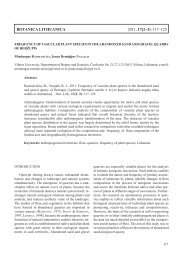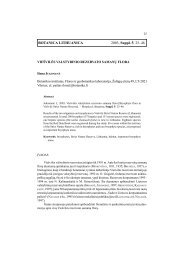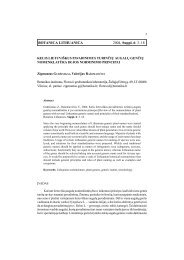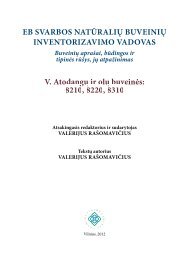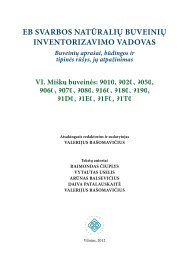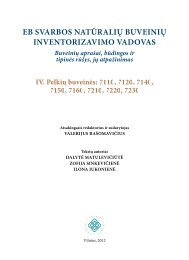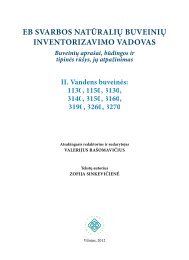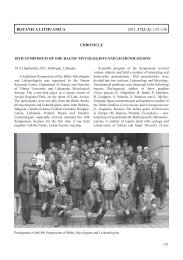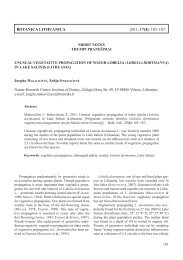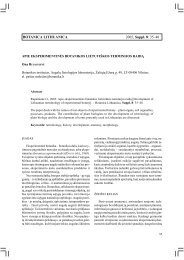FUNGI AND LICHENS IN THE BALTICS AND BEYOND XVIII ...
FUNGI AND LICHENS IN THE BALTICS AND BEYOND XVIII ...
FUNGI AND LICHENS IN THE BALTICS AND BEYOND XVIII ...
Create successful ePaper yourself
Turn your PDF publications into a flip-book with our unique Google optimized e-Paper software.
Among the collected 81 herbarium specimens 34 species of pyrenomycetous fungi<br />
were identified. They represent nine orders: Chaetosphaeriales, Coronophorales,<br />
Diaporthales, Hypocreales, Sordariales, Xylariales, Botryosphaeriales, Dothideales,<br />
Pleosporales. The highest number of species (17) belonged to the order Xylariales. Diatrype<br />
disciformis (Hoffm.) Fr., Valsa abietis Fr. and Dothidea sambuci (Pers.) Fr. were recorded for<br />
the first time in Lithuania.<br />
The identified species were found on various species of woody plants such as Pinus<br />
sylvestris L., Picea abies (L.) H. Karst., Fagus sylvatica L., Quercus robur L., Betula pendula<br />
Roth., Acer platanoides L., Corylus avellana L. and Frangula alnus Mill. The highest number<br />
of species was found on Fagus sylvatica. The pyrenomycetous fungi inhabited such types of<br />
substrates as dead lying twigs, dead lying branches, dead lying trunks, dead attached twigs,<br />
dead attached branches and stumps. The majority of the studied species was found on dead<br />
lying twigs and branches.<br />
The studied fungi inhabited wood debris with diameter from 0.2 up to 38 cm. Most of<br />
the inhabited substrates were 1.5 cm in diameter.<br />
PRELIM<strong>IN</strong>ARY DATA ON PYRENOMYCETES <strong>AND</strong><br />
LOCULOASCOMYCETES (Ascomycota) OF ALLUVIAL FORESTS (LITHUANIA)<br />
T. IZNOVA, J. RUKŠĖNIENĖ<br />
Vilnius University, Department of Botany and Genetics, M. K. Čiurlionio Str. 21/27, LT-<br />
03101, Vilnius, Lithuania<br />
E-mails: tatjana.iznova@gf.vu.lt, jone.rukseniene@gf.vu.lt<br />
The pyrenomycetes and loculoascomycetes were collected in six alluvial forests in<br />
Lithuania: Ignalina district (the Pakalniškiai and the Raistas forests), Lazdijai district (the<br />
northern part of the Ančia lake and the Rinkotas forests), Trakai district (the Spindžius forest)<br />
and Vilnius district (the Šveicarai forest). These forests belong to various EEC habitats.<br />
The material was gathered during April – June and September – November, 2010. The<br />
route method and two methods of stationary plots were applied for investigation of ecology<br />
and diversity of the studied fungi. The samples of pyrenomycetes and loculoascomycetes<br />
were collected using these methods twice in a month, in total 28 field trips in the abovementioned<br />
alluvial forests.<br />
In these forests circular plots (100 m 2 of area, 5.8 m radsius) were chosen for research<br />
using two stationary methods:<br />
1. In the above-mentioned forests, five plots have been selected for studies. In<br />
these plots samples of woody plant and grass debris, bearing pyrenomycetes and<br />
loculoascomycetes were collected. Approximately 15 samples were taken in each plot.<br />
2. In every studied forest five plots were selected for different investigation<br />
method. In these plots, 100 different samples of woody plant and grass debris were gathered<br />
by going round. Of these, only the samples with pyrenomycetes and loculoascomycetes were<br />
chosen for further research.<br />
Using both methods, preliminary results of various ecological aspects of the studied<br />
pyrenomycetes and loculoascomycetes are presented.



